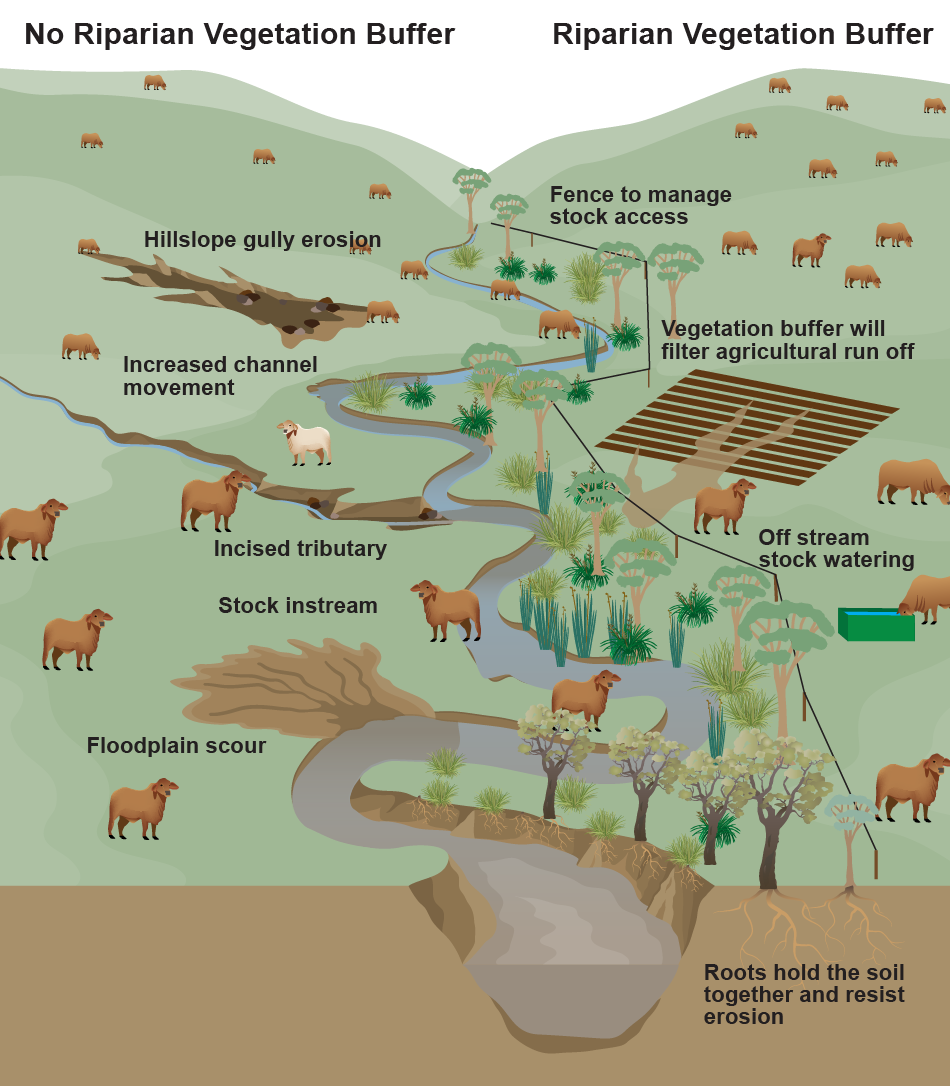|
|
Riparian fencing to control stock/feral animal accessFencing to exclude or control the access of domestic stock and feral animals to the river channel and adjoining riparian areas or other wetland systems can be an effective management technique. A range of fencing materials and methods (e.g. multi-strand, mesh, drop down, electric, virtual) can be used subject to the target animals for exclusion, the scale of the site, the adjoining land uses and the requirements of native animals to access the site. Unregulated access of domestic stock (e.g. cattle, sheep and horses) and feral animals (e.g. pigs, goats, deer) to the riparian area and channel can degrade vegetation, limit regeneration and revegetation, cause soil compaction, cause riverbank erosion, introduce weeds and add additional nutrients (leading to poorer water quality) and pathogens. For example, calves shed 57 million oocysts per day on average in their manure which may include cryptosporidium. This number can be compared to a beef cow, which sheds on average 2,400 or a dairy cow at around 80,000 oocysts per day (Juvenile stock in waterways). Fencing may involve total exclusion of target animals or controlled seasonal access of grazing stock to the riparian zone. Controlled access facilitates beneficial outcomes such as grazing of palatable weeds and the control of dry season fire fuel loads. Managed animals predominantly include domestic grazing stock (e.g. cattle, sheep and horses). Feral animals can include cattle, horses, donkeys, pigs, goats, deer, feral predators such as foxes and invasive species such as cane toads. Potential benefits from this intervention:
Potential negative implications from this intervention:
Intervention considerations:
Additional informationPublications: Doupé, R.G., Mitchell, J., Knott, M.J., Davis, A.M., and Lymbery, A.J. 2010. Efficacy of exclusion fencing to protect ephemeral floodplain lagoon habitats from feral pigs (Sus scrofa). Wetlands Ecology and Management 18, 69-78. Price, P. and Lovett, S. 1999. Riparian Land Management Technical Guidelines. LWRRDC Canberra. Rutherfurd, I.D., Jerie, K. and Marsh, N. 2000. A Rehabilitation Manual for Australian Streams, Volumes 1 and 2. CRC for Catchment Hydrology and LWRRDC. Canberra. Tait, J. 2011. Guidelines for the Use of Grazing in the Management of Exotic Pasture Weeds in Wetland and Riparian Habitats. WetlandCare Australia, Ballina, NSW. Waltham, N., and Schaffer, J. 2017. Continuing aquatic assessment of wetlands with and without feral pig and cattle fence exclusion, Archer River catchment. TropWATER James Cook University, Townsville Australia, p. 44. WetlandCare Australia. 2008. Wetland Rehabilitation Guidelines for the Great Barrier Reef catchment. Compiled for Department of the Environment, Water, Heritage and the Arts. Links: Queensland Government Feral pig population control techniques Australian Government Department of Agriculture, Water and the Environment Reef Trust Gully and Stream Bank Toolbox 3rd Edition, March 2022 (awe.gov.au) NSW Government and Australian River Restoration Centre Stock And Waterways Guideline – a practical guide to help New South Wales farmers manage stock and waterways for productivity and environmental benefits. Victorian Government Controlled grazing guidelines within the fenced riparian areas Victorian Government Flood-prone Fencing Guidelines Victorian Government Juvenile stock in waterways information Last updated: 28 June 2022 This page should be cited as: Department of Environment, Science and Innovation, Queensland (2022) Riparian fencing to control stock/feral animal access, WetlandInfo website, accessed 8 May 2025. Available at: https://wetlandinfo.des.qld.gov.au/wetlands/management/rehabilitation/rehab-process/step-4/intervention-options/stock-feral-animal-access-mod.html |

 — Department of the Environment, Tourism, Science and Innovation
— Department of the Environment, Tourism, Science and Innovation


